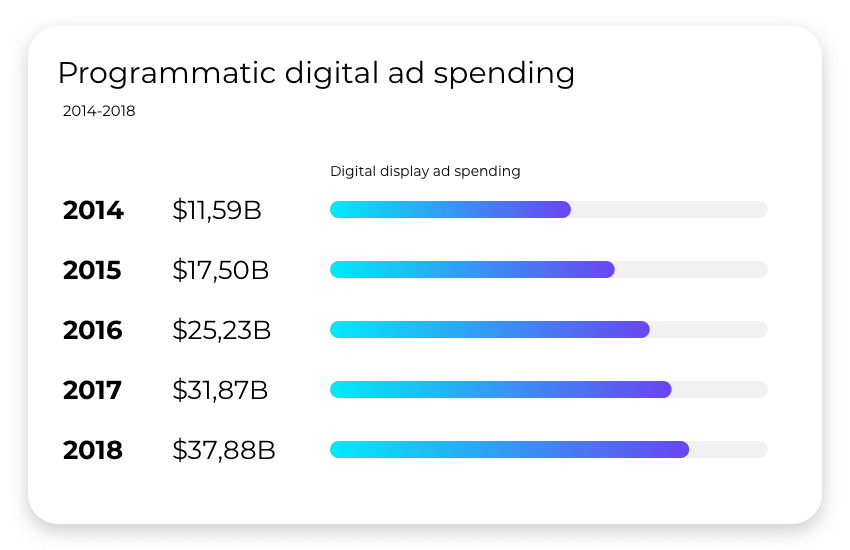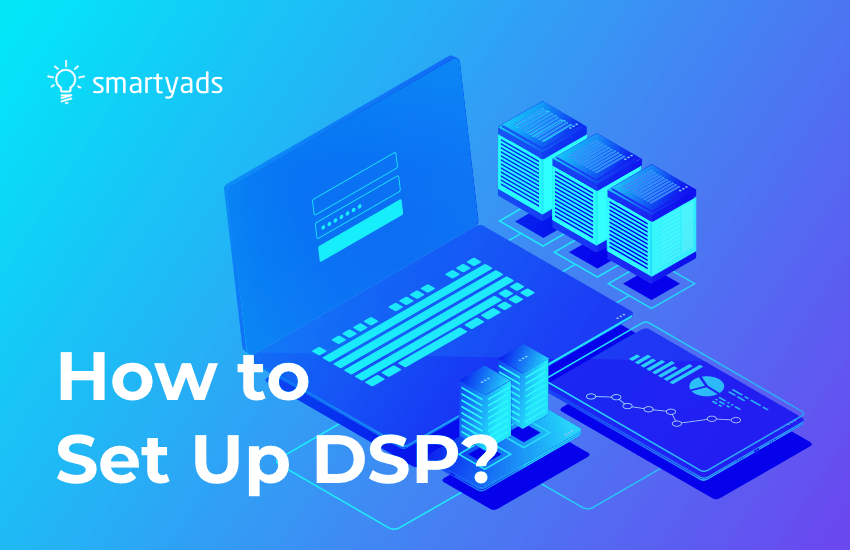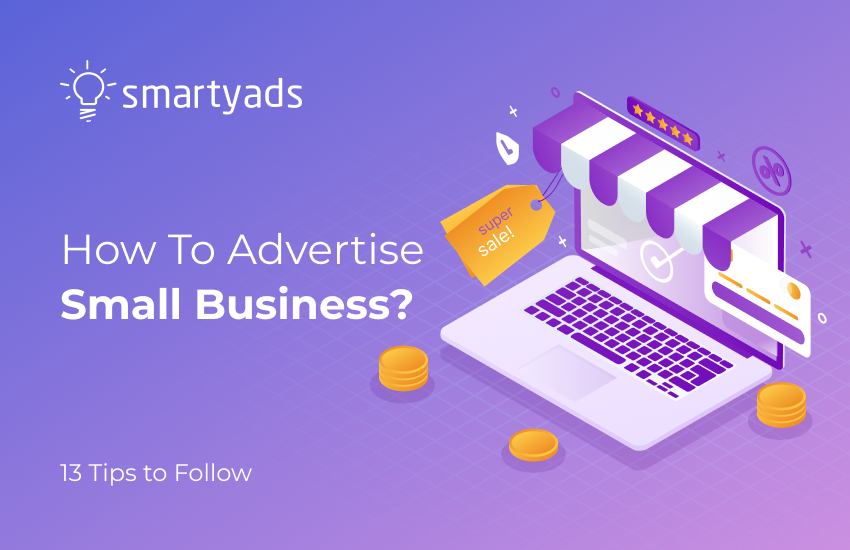Brands don’t believe in media agencies anymore. IAB Europe Report clearly shows that both advertisers and publishers tend to develop their own programmatic advertising strategies instead of relying on external partners. Around 40% of advertisers handle their online media buying in-house, half of the publishers stick to this model as well.
It is reported, that 47% of brands embrace hybrid in-housing with a focus on media strategies, KPI establishment, and data management via the demand-side platform. When it comes to technology initiatives, companies outsource it. But if you ever thought about setting up your own DSP, you’re not alone.
How Common is Full-Stack In-House Among Companies?
According to IAB stats, only 18% of advertisers may boast of having a full ad tech stack for programmatic real-time bidding. That's not surprising since the development of your own DSP might take too much time and effort. You need to hire ad tech engineers, undergo a long development cycle, provide a budget for maintenance, and literally “reinvent the wheel” creating ad-server and bidder features for your DSP.
Along with these complexities, advertisers may significantly improve ad performance and eliminate commissions, having their own DSP under control.
By building a custom DSP agencies may expand their offerings and add real-time bidding to their service lists. Even though the programmatic market is already saturated, the demand for good ad tech providers is still rising.

In 2018 programmatic digital display ad spending has grown to $37, 88 from $31,87 established in 2017. At the same time, the programmatic’s share is only 82% filled so there’s always room for new real-time bidding DSP’s to appear.
Ready to learn how to set up your own DSP? Then you have two options: build it from scratch or choose the white label DSP and customize it according to your needs. To decide which one suits you better, it is important to know the pros and cons of every model but first let’s examine how DSP actually works.
How Does a Demand-Side Platform Work?
A Demand-Side Platform is a cornerstone of programmatic ad buying. It is a piece of ad tech software that purchases inventory from publishers on behalf of advertisers via real-time bidding protocol and ensures delivery of ads of various formats on websites by ad servers. DSPs automatically connect advertisers to Ad Networks, Ad Exchanges, and Supply-Side Platforms and match the best bid with the certain inventory without human participation.
Learn more about the main features of a DSP.
How exactly does a DSP work? The process of ad buying via DSP includes 5 steps:
An advertiser starts the ad campaign in a DSP specifying various data attributes of their target audience and adjusting budget settings.
A DSP sends a request to ad exchanges and networks to access available inventory.
A DSP analyzes what inventory matches specified parameters and selects suitable slots.
A DSP evaluates the cost of the inventory and automatically bids on the impression based on predefined budget data.
If the bid wins in the auction, a DSP sends a request to the ad server to deliver the ad to the end-user.
The process of ad serving may seem long, but it actually takes no more than 100 milliseconds while the webpage is loading.
What Do You Need to Set Up Your Own DSP
If you decided to build a DSP from scratch, you need to develop a number of algorithms responsible for bidding, data processing, and ad serving to implement the mechanism mentioned above. The first component of a DSP is an RTB bidder. It evaluates inventory and determines the right value for each impression. Major bidder’s features you need to develop:
A strong CPM bidding algorithm to choose the best request to bid on;
A single-point management system to handle connections between ad campaigns, advertisers, ad exchanges, etc.
Targeting/re-targeting algorithms for precise ad serving to the buyer’s target audience;
In addition to algorithms, to build an RTB bidder for your own DSP, you might need a machine learning engineer and data specialists.
An ad server decides which ads to serve on the website, displays them to the user, and reports conversion data. Features to work on:
PC and mobile ad serving algorithm;
CPM maximizer algorithm to determine the best value per impression;
Conversion tracking mechanism to provide constant feedback to advertisers, so they could run more cost-effective campaigns;
Workflow management options;
Selection, ranking, and filtering algorithms;
Brand safety solutions to detect fraudulent ad inventory and prevent its purchase;
Ad serving and traffic reporting, 3rd party data collection features, etc.
To put ad server features into practice, you need a data-crunching specialist and/or big data engineer.
Also, it’s desirable to establish an internal data platform to retrieve additional user information from external DMPs and make targeting options more precise. The data platform is also needed for the data feed to the ad server and bidder. The development of such a platform requires a big data engineer.
If you want to win more clients, you might equip your DSP with additional modules, such as profit maximization, supply forecasting, CTR prediction, and other algorithms. After compiling all these components together, you’ll get a fully functioning custom DSP.
Pros and Cons of Building a DSP from Scratch
There’s definitely a lot of work to do if you want to set up your own DSP from scratch. Is the game worth the candles? Let’s review the pros and cons of full-stack DSP development.
PROS of Building Your Own DSP | CONS of Building Your Own DSP |
No margin on media buying, which comes with external DSPs and results in the long-term cost-saving; High customization opportunities to improve ad performance and targeting accuracy; Ability to provide your customers with up-to-date programmatic technology. This forms a new revenue stream for your business; Ability to sell your product to other brands using white label DSP and boost revenue even more; Limitless integrations with the rest of the in-house platforms; Full control over data processing and management; Intellectual property ownership. | High time and money expenditures on development and maintenance (if not based on ready-made White Label solution); Long development cycle — it might take a year or two before you’ll be able to use your DSP to the full extent. Struggles with educating/hiring specialists, integrating exchanges, and algorithm testing. If you decided to involve your own staff, programmatic has long learning curves; The necessity to build relationships with major ad networks and exchanges, which requires an established credibility upfront; |
How much does exactly a full setup of a DSP cost? Technology investments may comprise up to $1.5 - $2.5 million per year. This sum includes engineering team salaries, infrastructure, maintenance expenses, and development costs. For example, disk storage of data for post-processing drains around $3,500 per month, that’s $42,000 per year.
If you run a small agency or a startup brand, the development expenses may exceed your earnings from advertising. It makes sense to set up a DSP from the ground up only if your advertising budget is more than $50M per year. Only in this case, you save money in the long run.
Otherwise, you can consider an alternative solution — a white label programmatic DSP. It holds all benefits of a custom platform and almost none of the disadvantages as expenses on development are removed, the maintenance is guaranteed, and the necessary chain connections are already made.
A White Label Programmatic DSP as an Alternative Solution
There is a common myth that you can become a #1 in your niche only if you develop a unique technology from scratch. That’s not exactly true.
For example, Youtube initially bought the video technology from Adobe and applied only cosmetic changes to its core. All videos on Youtube were played through a 3rd-party Adobe software until the service was purchased by Google in 2006. Nevertheless, that didn’t prevent Youtube from becoming the most popular video-sharing website in the world.
Similarly, you don’t need to develop a DSP on your own if you want to become a #1 in online advertising, just acquire a ready-made solution and build your own service model on it.
What is a White Label DSP?
A white label DSP is a ready-to-use demand-side platform that doesn’t bear any brand name and is ready for reselling. The buyer shapes up the product according to their own needs and offers it to clients as their own programmatic advertising solution.
The majority of white label DSPs are highly customizable. You can build a custom UI and interfaces, adjust DNS settings, and fine-tune algorithms of your newly branded platform.
As we mentioned above, white label DSP shares the benefits of a platform built from the ground up. Sure thing, it’s not free but it’s easy to calculate that the platform will quickly pay off compared to the budget needed for development.
What’s even more important, such a model allows capitalizing on the platform straight from the moment of buying. Purchasing a white label DSP, you get instant access to thousands of publishers, hundreds of exchanges, and dozens of relevant extensions, increasing the value of each impression.
Utilize the Best White Label DSP from SmartyAds
Let’s split the chores: you build a business, we build technology. SmartyAds White Label DSP gives you a competitive edge in digital advertising by:
Supporting all ad formats available on the web (display, native, mobile, video, etc);
Implementing precise targeting based on 1st and 3rd-party user data with full compliance to GDPR;
Matching ads with the best inventory for the lowest possible price;
Supporting best-performing techniques such as desktop and in-app header bidding;
Providing real-time analytics and reporting.
Our white label platform is a ready-made solution, so after purchasing you can brand it and customize UI according to your needs and tastes. No ad tech knowledge is needed to set up your own DSP using SmartyAds technology. This means you will launch your first campaign or resell a ready-made solution to your clients in a matter of days.
Don’t spend years on building a DSP from scratch — buy a SmartyAds white label DSP and create your own programmatic universe!




